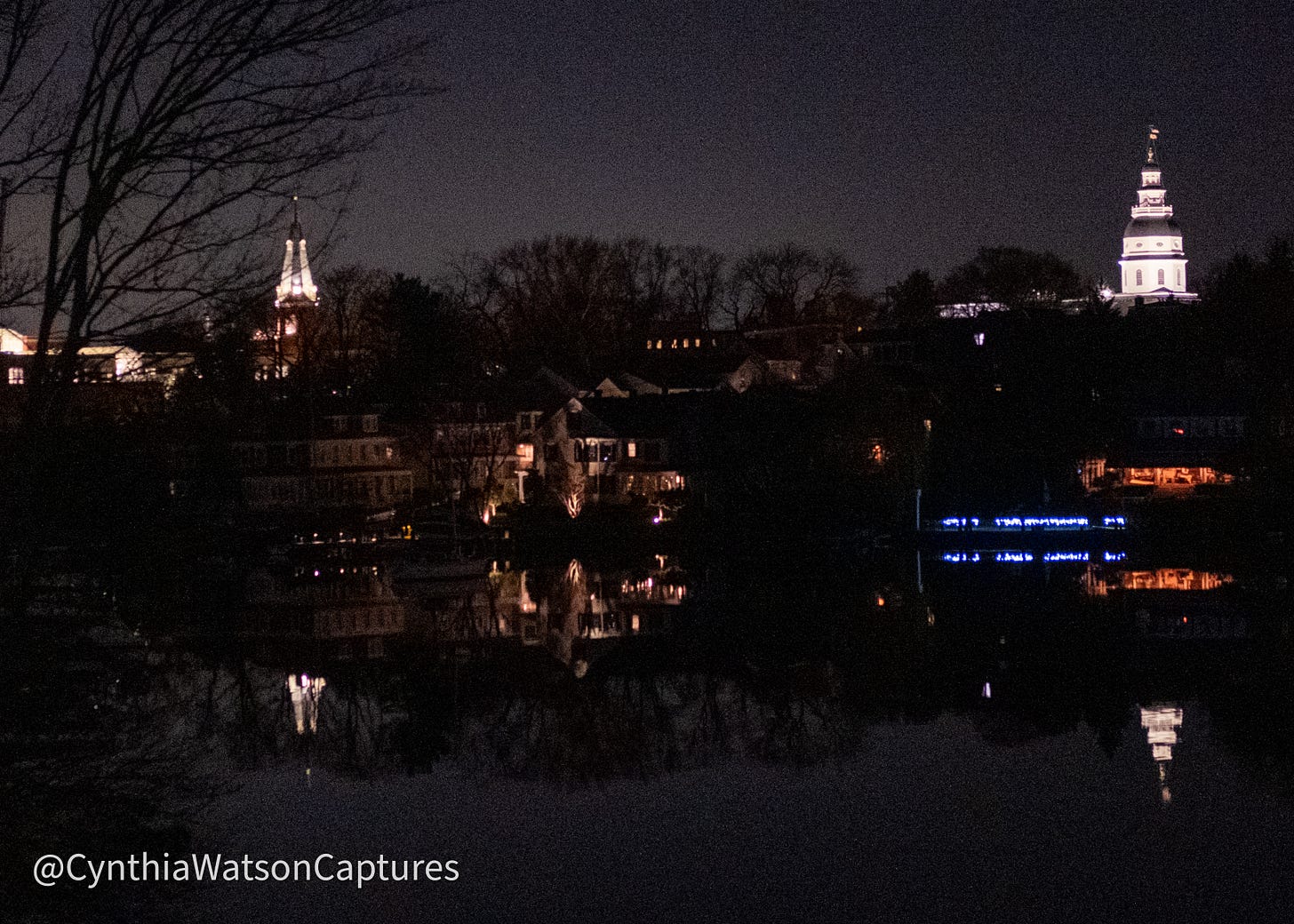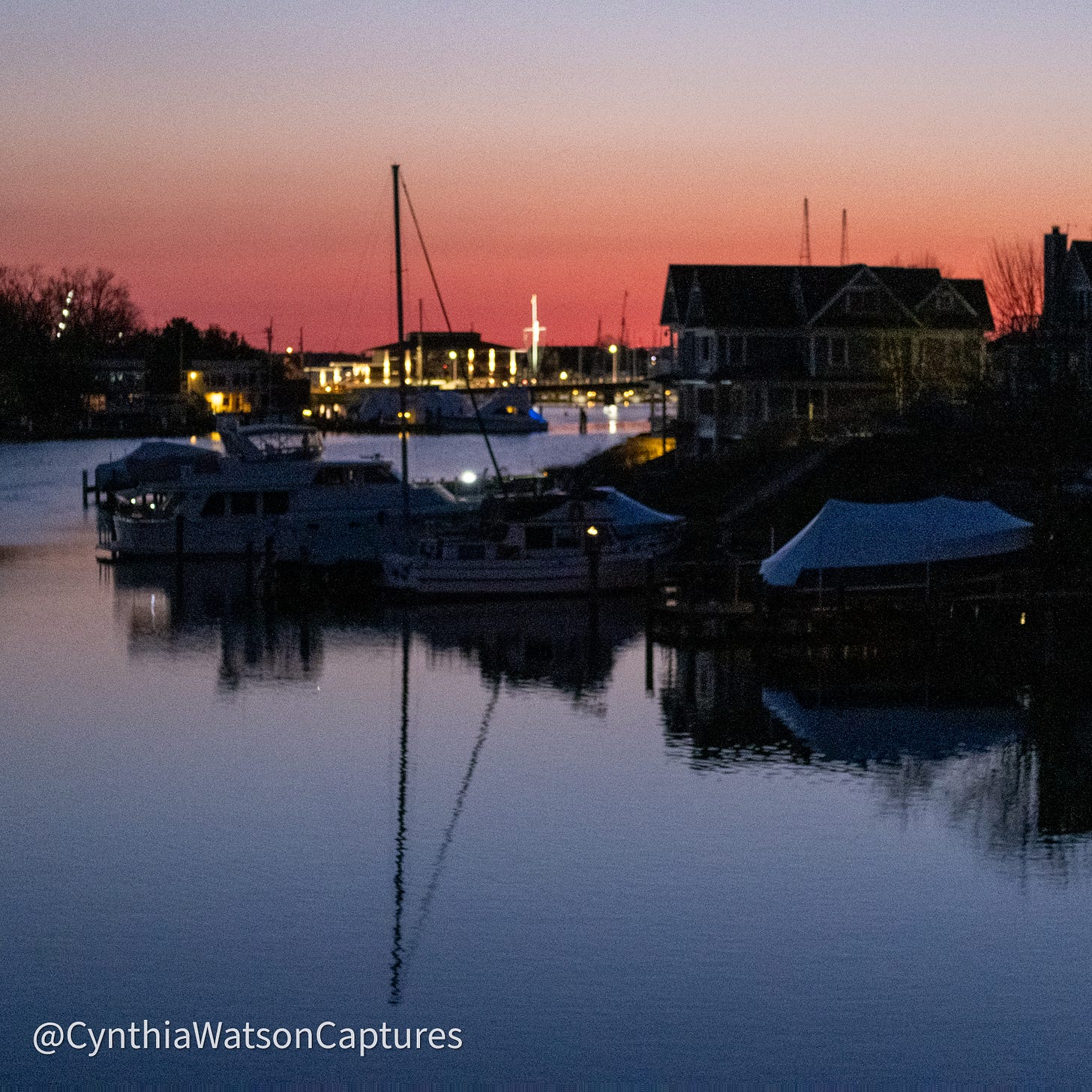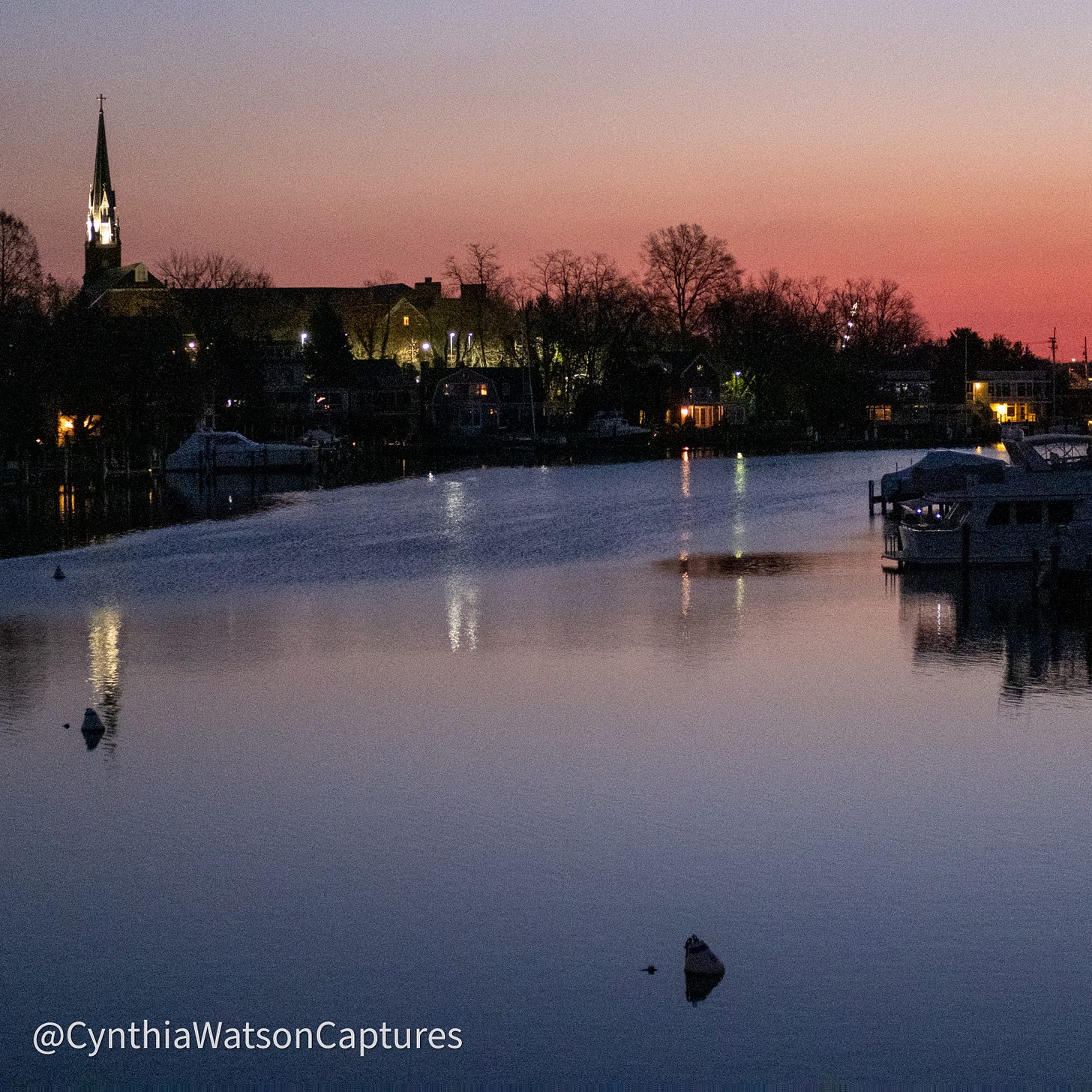Spa Creek was incredibly still at 0445 this morning. I ventured into the studio, a.k.a. the balcony, without a tripod, wondering if I could catch at good reflection of the crystal clear lights on the Annapolis shore.
As I have noted, the pandemic, that experience which initially upended our lives four years ago this week, gave me time to focus on photography to provide some hope or an outlet for me (and later others) to think about something other than the seeming unending isolation. I am completely self-taught in photography, invariably by trial and error. I read a few things by professional critics but take them with grains of salt since I have learned that most critics are merely asserting their preferences rather than some pass/fail assessments to the quality of photographs (My favourite Twitter comment of all time was a commercial photographer who observed dryly last year that the difference between professionals and amateurs was a lot smaller than some photographers want to acknowledge. Of course I loved that one!). I am keener on reviews that give me some detailed comments on why a particular lens would be terrible for wildlife or the autofocus too slow for an ice hockey game but I make my own choices on what I think fits my needs.
Cartagena, Colombia 2015–pretty boring snapshot
I learn by trying, tossing what I don’t like, then trying again. And I toss out hundreds of shots. It’s one of the most amazing things about digital photography: no one penalises you for rejecting all but one shot out of a thousand, if you so desire. The current price of scan cards for digital cameras allow you to save all the crappy shots, if you like, on countless little digital cards because they are relatively speaking so cheap. I mean cheap considering how expensive so much of tech is these days. I try to be a responsible buyer and citizen but admit I am psyched by the relative inexpense of cards for the digital camera. I know I am lucky I can afford these, as well.
Digital work is so immediate as to be the ultimate instant gratification. You take a photograph, you flick back through what is on your card, you see the image, and you make an immediate decision whether you find it too blurry or mis-framed for your purposes, then you hit two buttons to delete the image. Gone by pressuring a finger on the erase button after you identify the one objectionable shot (rather than hitting ‘delete all’, hopefully). If you want to save the image on a computer or an ipad, it’s an easy transfer. Those screens let you see the photograph in a bigger format which is so helpful.
All of this is opposed to the vintage system of developing film. Kids today have not the foggiest idea what that meant for people with a dark room in their basement. Little would they know the gallons upon gallons of water it took to develop the negatives and then prints. The time investment in letting the chemicals do their magic. The specialised papers, the machines for determining the size of the prints, and the clothesline to allow prints to hang for their drying. People used to do that for hours and hours and hours. Film photography appealed to purists and certainly created beautiful images but was a wholly different experience—and time line.
We had reached an era where we stopped selling film about a generation ago in the United States. I was travelling to China in about 2008 but did not want to take a digital card for fear something could get copied into my computer when I downloaded my photos so I decided I would drag out an old SLR (single lens reflex) camera from the dark ages for the journey. My shots with it were poor to middling but I was thinking snapshots (a word we don’t hear much except rather dismissively by real aficionados online these days when they are putting down some one’s work) from travel as my objective (rather than something more sophisticated) so I didn’t mind hauling a couple of roles of film en lieu of risking the danger of downloading anything malicious.
Intense colours on the Creek this morning
Except I could not find film to buy. Anywhere. Brick and mortar camera shops are far fewer in number these days but even the survivors rarely touted their film supplies. Online shops were busy selling endless variations of stylish digital equipment without the need for rolls of film. Besides, there were no longer a couple of yellow mailing envelopes in the Sunday newspapers so you could mail off your film, have some company develop it, then post the 3x5 or 4x6 prints and negatives back to you for a pretty cheap price. By the mid- 2000s, film was so passé along with landlines, black and white television, and normal elections.
Real photogs, as I call them, never used commercial developing envelopes for their services but slavishly locked themselves in dark rooms. But most people were never real photogs, either. I can’t claim to know how many of those types never gave up their film for digits but I suspect many just added the new format to their repetoires. That is what professionals do, isn’t it?
Today, film photography and vinyl records are en vogue again. Neither has captured their genre but they are no longer considered dead media. My brother who tracks these things says there are even plenty of places one can get film developed. Browsing photography fora, however, reveals many discussions of film photography, often focusing on rangefinder cameras. Few things ever seem to go away forever, do they?
What does this have to do with my reflection shots at 0445 this morning? I don’t shoot film and have no interest in returning to it. The cameras were bulky (some digital ones are as well but not mine), seemingly temperamental, and required a commitment to calculations for each and every single button click that simply don’t appeal to me. I am interested in the product rather than the process. Sacrilege but true.
My product is better than it used to be but will hopefully improve with more work. As I have noted on other topics in the past, humans too often overstudy things as if that studying the problem will guarantee improvement. Instead it’s often the act of trial and error providing better outcomes. I get discouraged occasionally when I see what others are able to do but take comfort other photographers of all levels likely have their similar moments of self-doubt born of comparison.
But, I have also learned that what matters is the opportunity to shoot interesting scenes and to provide any satisfaction I can to someone else. Photography isn’t about gaining ‘likes’ on facebook but it does bring satisfaction to know you provided someone with even a moment’s pleasure. Small pleasures are what matter in life—for ourselves and for others.
Actions create consequences. Photography is one of the countless activities exemplifying this in so many ways. I just wish I had realised how much joy and education I get from looking closely at other people’s work a long, long time ago instead of writing them off as so good I could not learn from them. Far from it: I learn from every single shot I look at. Wow.
Thank you for reading this column today. I realise photography isn’t all that interesting to some of you but is there a parallel activity in your own life to which this applies? Cooking? Painting? Yoga? Dressmaking? I would love to read your thoughts on my actions and consequences pieces.
I appreciate your time and I especially thank the subscribers for their continuing support.
Be well and be safe. FIN









